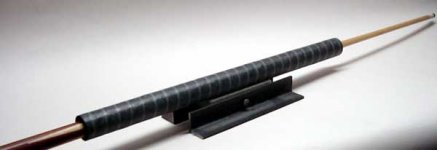Johnnyz86 said:
[...] the one thing i cannot change and get working better even after months is elbow drop.
[...]
any advice?
My advice is to stick with it for another several months and maybe visit an instructor along the way.
When the discussion of elbow drop comes up, responses here often mix apples and oranges and pears. Here is my perspective on the issue.
If you were to install webcams in a hundred poolrooms throughout the world and view 1000 random elbow drops on pool strokes, those 1000 strokes might be divvied up as follows:
990 strokes: category A elbow drops
9 strokes: category B elbow drops
1 stroke: category C elbow drop
category A elbow drops--
the vast majority of them--are plainly and simply bad mechanics. This person's elbow is moving during the stroke, as perhaps is his or her head, making strokes inconsistent, making strokes rely on carefully choreographed timing of different motions, and encouraging the addition of other compensating motions. These people absolutely will benefit from learning good mechanics like those Randy and Scott and Steve and others advocate so well. These people should heed the advice of instructors like those I just mentioned and practice it until one nipple is as calloused as the bottom of a foot, imo.
category B elbow drops--
These are solid players whose elbow is still at the time of contact. The stroke is a simple pendulum stroke until after the cueball is gone. The impetus for dropping the elbow in the follow through perhaps comes from the desire to have a long, exaggerated follow through, or perhaps it comes from wanting a level, horizontal follow through (instead of the tip approaching the cloth as in the pendulum stroke). These people don't necessarily need to change anything. The biggest problem they cause is for others. They embolden the category A folk--who don't recognize the difference--thus providing a disincentive for the category A folk learning good mechanics.
Category C elbow drops--
This is, for example Mike Massey. These people are capable of a good pendulum stroke and perhaps employ a pendulum stroke on most of their shots. However, on power strokes, e.g., a break shot or a power draw shot, you will see an elbow drop. These players' elbows are moving at contact because the point is to add some speed by pivoting about the shoulder. In fact focusing on the elbow drop is like focusing on the thunder instead of the lightning. The lightning here is the elbow raise on the backstroke. Then pivoting about both the shoulder and elbow on the forward stroke increases speed. Most players, imo, should never do this for, say, a draw shot. The reason is that while the speed increases a bit, the bigger effect is our precision in where we contact the cueball goes down by a more significant amount. So I would say if you can't consistently draw one and a half table lengths with a pendulum stroke, then there's no way you should be futzing with this stuff. And if you CAN consistently draw one and a half table lengths with a pendulum stroke, then...well..you're more or less good to go!

